Countertop edges: which finish to choose?
The edges of stone countertops are a significant kitchen accent. By choosing the appropriate edge profile, you can highlight or create your kitchen character and mood. Perhaps you're even considering to install stone windowsills in your house? Then the same can be said about the relationship of windowsills with the design of the rooms. Windowsill edges can be matched to the existing style of the living room or bedroom, or vice versa - give these spaces a certain style by using an appropriate edge profile.
This is what you should know about countertop and windowsill edges to achieve not only a beautiful but also a practical interior.
- The more rounded the edge line, the more resistant it is to impacts. A rounded edge of the countertop or windowsill is less prone to chipping, and there's less chance that such an edge will be damaged when struck by a heavy or sharp object. In places where there's a high risk of impact (such as sinks), it's recommended to use a 2mm radius edge.
- The larger the radius of the edge, the more the inner color of the countertop is highlighted. This doesn't matter if you're making a countertop from natural stone or engineered quartz, as the internal color of these materials is the same as the surface color (the pattern is full-bodied). However, when making a countertop or windowsill from sintered stone, ceramics and porcelain, you'll notice that not all slabs have the same internal color and pattern as the surface of the slab. Most of these slabs have a monochrome interior.
- The fewer grooves and waves milled into the edge, the easier it is to maintain the countertop. Smooth edges don't trap dirt and dust, eliminating the need to scrape off trapped food residues from the edges.
- If there are small children in the house, it's better to opt for slightly rounded countertop edges. While straight, clean lines look stunning, sharp corners can be dangerous for playing children.
Straight edges


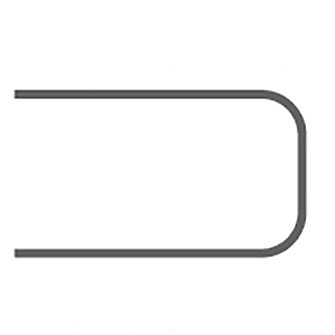
A straight edge is cut at a 90-degree angle, creating a flat front edge. It visually enhances the thickness of the countertop to its maximum possible appearance. Usually, straight edges are slightly eased (softened) by rounding off the top or both sharp sides so that they are not too sharp. Eased edges are particularly suitable for modern, minimalist kitchen interiors and complement most contemporary architectural styles. Other edge profiles visually slim down the surface. Softened edges are safer for children and reduce the risk of chipping from external impacts. Compared to all other profiles, eased or rounded straight edges are the easiest to clean. Additionally, any spills on the countertop will drip straight onto the floor, rather than towards cabinets and down. Straight edges are perfect for those aiming for a clean kitchen design.
Bullnose edges
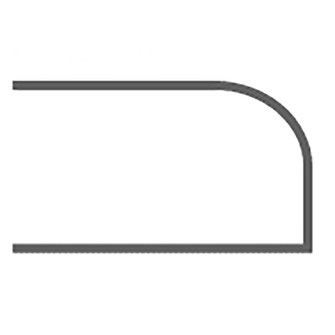
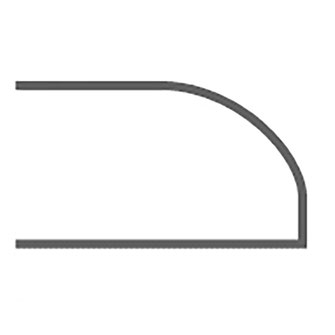

Round countertop edge on top and flat on the bottom is called half bullnose or demi-bullnose, and round edge on both sides is called bullnose. Curved lines give the countertop a softer, warmer appearance. If you want your countertop to be easy to clean, it's better to choose the half-bullnose or demi bullnose profile rather than bullnose on both sides. This way, any spills on the countertop will drip straight onto the floor, rather than flowing through cabinet fronts. Round on both sides bullnose edge is best suited for countertops and bars with a longer overhang, such as a breakfast corner or a bar. The more rounded the edge, the more resistant it is to impacts, with very little chance of chipping. Countertops with rounded edges appear slimmer due to the curved profile.
Beveled edges


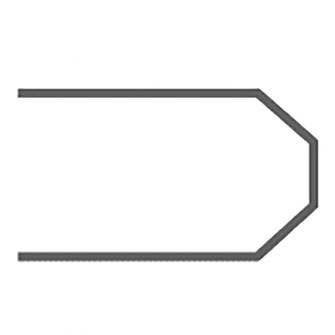
A beveled edge gives the countertop a sense of sharpness and complements a modern, neat and sleek kitchen style. Edges can be cut at various angles from the top or from both sides. The most commonly chosen angle for the bevel is a 45-degree cut on the upper edge of the countertop. It's possible to cut only the edge of the countertop or to remove a deeper chamfer, depending on the desired effect. A beveled countertop edge is more resistant to impacts than a straight one. There's a low chance of it chipping or breaking when hit with heavy pots and pans. However, the more of the countertop volume is cut away, the thinner the edge becomes, reducing its resistance to impacts.
Thin edges
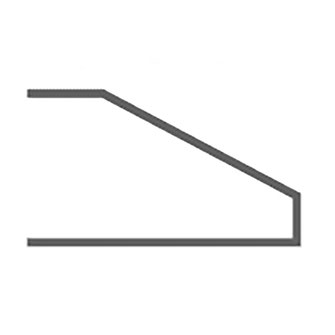

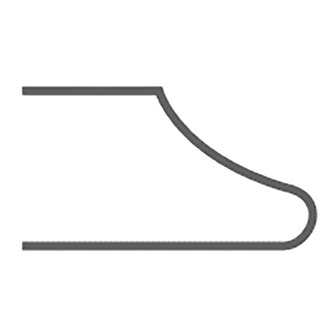
A flat edge gives the countertop a thin effect, which is particularly suitable for a modern, minimalist style kitchens. You can achieve an even greater visual thinness effect by choosing to chamfer the lower edge of the countertop while leaving the upper edge straight or eased. This edge is convenient when installing cabinet fronts with no handles underneath the countertop since there is enough space to grip the doors. These edge milling methods provide the countertop with lightness and elegance.
Classic edges



Classic edges are suitable for most French and Mediterranean-style kitchens, which often feature many intricate design details. The Dupont edge profile stands out with a slight 90-degree angle that descends like a cascading edge. The Dupont edge enhances the elegance and luxury of the kitchen, especially when paired with a marble countertop. However, food residues and dust may accumulate on the sharp profile of this edge, requiring more time and effort to clean the countertop. On the other hand, the Ogee edge is easier to clean, but note that its upper edge is very sharp and straight. The elegant Ogee edge complements well classic and traditional-style kitchens. Lastly, the waterfall edge is suitable when you want the countertop to become the main focal point of the kitchen and highlight the beauty of the chosen stone.
Other edge styles




The more complex the countertop edge, the higher is the cost of the countertop. Conversely, opting for standard edges will not significantly increase the countertop fabrication costs, as simpler milling methods are cheaper. Countertops with elaborate non-standard edges are more expensive because their production requires more time and effort. Though intricate countertop edges significantly contribute to the expressiveness of the kitchen, simpler edges are more versatile. They suit a wider range of interior styles, always look good, and are less likely to go out of fashion.
Thick edges
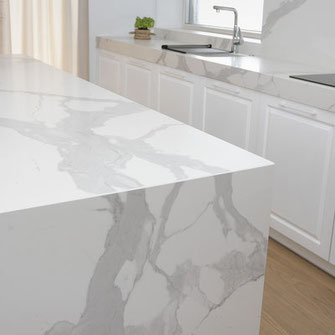
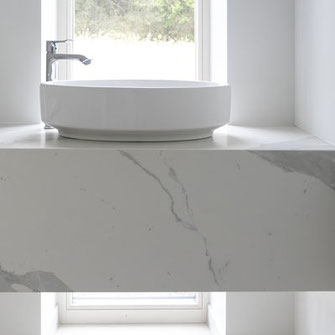
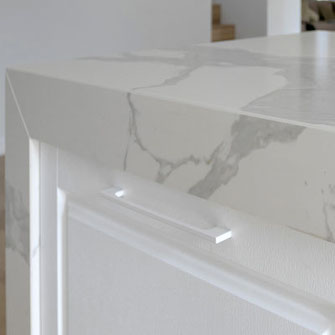
You can also come across countertops or windowsills with artificially thickened straight edges. The front part of these edges has the same appearance as the surface of the countertop. If the countertop has veins, usually, those veins are matched with the veins pictured on the edge. Looking at such a countertop, it seems that the stone veins are breaking through the edge and descending downwards. This method of edge processing is usually applied when countertops are made of thin natural or artificial stone slabs, or ceramic and porcelain tiles, whose inner filling color differs from the surface color. The countertop is joined with the edge at a 45-degree angle. Thick edges look aesthetically pleasing and luxurious, but at the same time, neat and minimalistic. Countertop and windowsill edges can be visually thickened as much as needed using this method. The edge can even be lowered to the floor level. Such a countertop looks as thick as its visible front edge.
Which edge finish to choose for your countertop?
If you're having trouble deciding which edge profile is most suitable for your countertop, take a look at the overall style of your kitchen. Pay attention to cabinet fronts, lighting fixtures, appliances, backsplash, and flooring. This will help you identify whether your kitchen style is already well-established or still developing. You'll see whether your kitchen features curved lines and intricate shapes or straight lines and a clean, minimalist style. The overall appearance of these details will help you decide on the countertop edge profile. The same applies to edge profiles for windowsills in other rooms or vanity unit edges in bathrooms.
